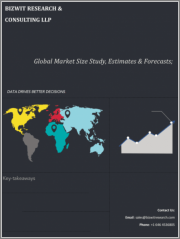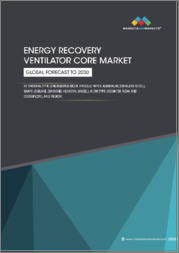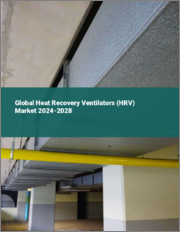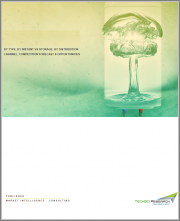
|
시장보고서
상품코드
1314965
세계의 에너지 회수 환기장치 코어 시장 규모 조사 및 예측 : 재료 유형별, 형상별, 플로우 유형별, 지역별 분석(2023-2030년)Global Energy Recovery Ventilator Core Market Size study & Forecast, by Material Type (Engineered Resin, Fibrous Paper, Others), by Shape (Square, Diamond, Hexagon, Wheel), by Flow Type (Counter-flow and Crossflow) and Regional Analysis, 2023-2030 |
||||||
세계의 에너지 회수 환기장치 코어 시장은 2022년에 약 9억 4,700만 달러로 평가되며, 2023-2030년의 예측 기간 중 7.5%를 넘는 건전한 성장률로 성장할 것으로 예상되고 있습니다.
에너지 회수 환기장치(ERV) 코어는 열 회수 환기장치(HRV) 코어라고도 하며 에너지 회수 환기 시스템의 핵심 컴포넌트입니다. 실내 공기질과 에너지 효율을 개선하기 위해 두 개의 개별 공기 흐름 사이에서 열과 습기를 전달하도록 설계되었습니다. 에너지 회수 환기장비 세계 시장 성장은 에너지 효율적인 건물 건설을 촉진하고 주거 및 상업 부문의 탄소 배출량 감소 정책을 시행하기 위한 정부의 개입에 의해 촉진되고 있습니다. 이러한 정부의 구상과 규제는 에너지 회수 환기장치 코어의 채택에 유리한 환경을 조성하여 전체 시장 성장에 기여하고 있습니다.
에너지 회수 환기장치 시장은 지속 가능한 건물 건설에 대한 관심이 높아짐에 따라 성장하고 있습니다. 이러한 추세는 유해한 배출량 증가로 인한 건강 문제에 대한 건물 거주자들의 인식이 높아짐에 따라 추진되고 있습니다. 미국그린빌딩위원회(USGBC)에 따르면 최신 IPCC 보고서는 세계 탄소 감축 목표를 달성하기 위해 토지, 에너지, 건물, 교통 및 도시의 지속가능성을 향한 신속하고 종합적인 전환을 요구하고 있습니다. 건물은 세계 에너지 관련 CO2 배출량의 약 40%를 차지하며 지속 가능한 변화를 추진하는 데 필수적입니다. 친환경 건물은 탄소, 물, 에너지, 폐기물을 줄이는 데 도움이 됩니다. 미국 조달청이 관리하는 22개 LEED 인증 건물을 조사한 결과, CO2 배출량은 34%, 에너지 소비량은 25%, 물 사용량은 11% 감소했으며, 8,000만 톤 이상의 폐기물이 매립지에서 전환되었습니다. 이에 따라 에너지 회수 환기장치 시장은 향후 수년간 큰 폭으로 성장할 것으로 예상됩니다. 에너지 회수 환기장치(ERV) 시장은 신규 프로젝트 수요 증가로 긍정적인 영향을 받고 있습니다. 에너지 회수 환기장치(ERV)는 나가는 공기로부터 열과 습도를 전달하여 들어오는 신선한 공기를 미리 조절함으로써 HVAC 시스템의 부하를 줄이는 데 중요한 역할을 합니다. 이 기능은 건설사, 건설업체 및 인프라 개발자들로부터 큰 관심을 받고 있습니다. ERV 시스템은 열과 물질의 이동을 효율적으로 수행하여 HVAC 시스템의 작업 부하를 효과적으로 줄일 수 있습니다. 현재 실내공기질(IAQ)의 중요성에 대한 인식과 인식이 높아지고 있습니다. 이에 따라 고품질 실내 공기를 개선하고 유지하기 위해 ERV에 대한 수요가 증가하고 있습니다. 에너지회수형 인공호흡기(ERV) 시장 성장은 복잡한 설치 절차의 존재로 인해 방해받고 있습니다. 또한 이러한 시스템의 설계 및 설치에는 종종 추가 공기 덕트가 필요하기 때문에 유지보수 비용이 증가합니다.
세계의 에너지 회수 환기장치 코어 시장 조사에서 고려된 주요 지역에는 아시아태평양, 북미, 유럽, 라틴아메리카, 중동 및 아프리카가 포함됩니다. 주택 부문에 대한 투자의 증가에 의해 북미가 2022년 시장을 독점하고, 부문 전체에서 안전하고 건강한 실내 환경을 제공하기 위한 에너지 회수형 환기 설비 설치의 필요성이 높아질 것으로 예상됩니다. 아시아태평양은 에너지 회수 환기장치(ERV)의 도입 증가 및 중국, 인도, 말레이시아, 한국, 태국 등의 국가에서 생활수준의 향상 등의 요인에 의해 예측 기간 중 대폭적인 성장이 전망됩니다. 이 국가는 인구의 변화하는 수요 및 선호도에 맞추어 주택 및 상업용 건물 스톡의 현대화를 우선하고 있습니다.
이 조사의 목적은 최근 다양한 부문 및 국가의 시장 규모를 정의하고, 향후 수년간 시장 규모를 예측하는 것입니다. 이 보고서는 조사에 참가하고 있는 국가 업계의 정성적 및 정량적 측면 양측을 포함하도록 설계되고 있습니다.
이 리포트는 시장의 미래의 성장을 정의하는 촉진요인 및 과제 등의 중요한 측면에 관한 상세 정보도 제공합니다. 또한 경쟁 구도와 주요 기업의 제품 제공의 상세 분석과 함께 이해관계자가 투자할 수 있는 마이크로 시장의 잠재적 기회도 포함되고 있습니다.
목차
제1장 주요 요약
- 시장 스냅숏
- 세계 시장·부문별 시장 추산·예측, 2020-2030년
- 에너지 회수 환기장치 코어 시장, 지역별, 2020-2030년
- 에너지 회수 환기장치 코어 시장, 재료별, 2020-2030년
- 에너지 회수 환기장치 코어 시장, 형상별, 2020-2030년
- 에너지 회수 환기장치 코어 시장, 플로우 유형별, 2020-2030년
- 주요 동향
- 추정 조사 방법
- 조사 전제조건
제2장 세계의 에너지 회수 환기장치 코어 시장 정의와 범위
- 연구의 목적
- 시장의 정의와 범위
- 업계의 진화
- 조사 범위
- 연구 대상년
- 통화 환산율
제3장 세계의 에너지 회수 환기장치 코어 시장 역학
- 에너지 회수 환기장치 코어 시장 영향 분석(2020-2030)
- 시장 촉진요인
- 에너지 효율이 높은 건설의 촉진을 목적으로 한 정부 개입의 증가
- 유해 배출물의 증가에 수반하는 건강상 우려에 대해 건물 점유자 사이에서 의식이 높아지고 있다.
- 시장이 해결해야 할 과제
- 에너지 회수 환기장치 코어의 고액의 정비 비용
- 복잡한 인스톨 절차
- 시장 기회
- 새로운 프로젝트의 수요 증가
- 고품질 실내 공기를 개선 및 유지하기 위한 ERV에 대한 수요의 증가
- 시장 촉진요인
제4장 세계의 에너지 회수 환기장치 코어 시장 : 산업 분석
- Porter's 5 Force 모델
- 공급 기업의 교섭력
- 구매자의 교섭력
- 신규 진출업체의 위협
- 대체품의 위협
- 경쟁 기업간 경쟁 관계
- Porter's 5 Force 영향 분석
- PEST 분석
- 정치적
- 경제적
- 사회적
- 기술적
- 환경
- 법적
- 주요 투자 기회
- 주요 성공 전략
- COVID-19 감염증의 영향 분석
- 파괴적인 동향
- 업계 전문가의 시점
- 애널리스트의 권장사항과 결론
제5장 세계의 에너지 회수 환기장치 코어 시장 : 재료별
- 시장 스냅숏
- 세계의 에너지 회수 환기장치 코어 시장 : 재료별, 실적 - 잠재력 분석
- 세계의 에너지 회수 환기장치 코어 시장 : 재료별, 추정·예측 2020-2030년
- 에너지 회수 환기장치 코어 시장, 하위 부문 분석
- 엔지니어링 레진
- 섬유질 종이
- 기타
제6장 세계의 에너지 회수 환기장치 코어 시장 : 형상별
- 시장 스냅숏
- 세계의 에너지 회수 환기장치 코어 시장 : 형상별, 실적 - 잠재력 분석
- 세계의 에너지 회수 환기장치 코어 시장 : 형상별, 추정·예측 2020-2030년
- 에너지 회수 환기장치 코어 시장, 하위 부문 분석
- 사각
- 다이아몬드
- 육각형
- 차륜
제7장 세계의 에너지 회수 환기장치 코어 시장, 플로우 유형별
- 시장 스냅숏
- 세계의 에너지 회수 환기장치 코어 시장 : 플로우 유형별, 실적 - 잠재력 분석
- 세계의 에너지 회수 환기장치 코어 시장 : 플로우 유형별, 추정·예측 2020-2030년
- 에너지 회수 환기장치 코어 시장, 하위 부문 분석
- 크로스 플로우
- 역류
제8장 세계의 에너지 회수 환기장치 코어 시장, 지역별 분석
- 주요 국가
- 주요 신흥 국가
- 에너지 회수 환기장치 코어 시장, 지역 시장 스냅숏
- 북미
- 미국
- 재료 유형 내역 추정과 예측, 2020-2030년
- 형상 내역 추정과 예측, 2020-2030년
- 플로우 유형 내역 추정과 예측, 2020-2030년
- 캐나다
- 미국
- 유럽의 에너지 회수 환기장치 코어 시장 스냅숏
- 영국
- 독일
- 프랑스
- 스페인
- 이탈리아
- 기타 유럽
- 아시아태평양의 에너지 회수 환기장치 코어 시장 스냅숏
- 중국
- 인도
- 일본
- 호주
- 한국
- 기타 아시아태평양
- 라틴아메리카의 에너지 회수 환기장치 코어 시장 스냅숏
- 브라질
- 멕시코
- 중동 및 아프리카
- 사우디아라비아
- 남아프리카공화국
- 기타 중동 및 아프리카
제9장 경쟁 정보
- 주요 기업의 SWOT 분석
- 주요 시장 전략
- 기업 개요
- Johnson Controls
- 주요 정보
- 개요
- 재무(데이터의 가용성에 따름)
- 제품 개요
- 최근 동향
- Daikin Industries, Ltd.
- Mitsubishi Electric Corporation
- LG Electronics
- Nortek Air Solutions, LLC
- Lennox International Inc.
- Fujitsu Limited
- DAERYUN Industry Co., Ltd.
- S&P USA Ventilation Systems, LLC
- UltimateAir, Inc.
제10장 조사 프로세스
- 조사 프로세스
- 데이터 마이닝
- 분석
- 시장 추정
- 검증
- 출판
- 조사 속성
- 조사 전제조건
Global Energy Recovery Ventilator Core Market is valued at approximately USD 947 million in 2022 and is anticipated to grow with a healthy growth rate of more than 7.5% over the forecast period 2023-2030. An Energy Recovery Ventilator (ERV) core, also known as a heat recovery ventilator (HRV) core, is a key component of an energy recovery ventilation system. It is designed to transfer heat and moisture between two separate air streams in order to improve indoor air quality and energy efficiency. The growth of the global market for energy recovery ventilators is propelled by government interventions aimed at promoting the construction of energy-efficient buildings and implementing policies to reduce carbon emissions in residential and commercial sectors. These government initiatives and regulations create a favorable environment for adopting energy recovery ventilators and contribute to the market's overall growth.
The market for energy recovery ventilators is experiencing growth due to the increasing trend towards the construction of sustainable buildings. This trend is driven by a growing awareness among building occupants about health concerns associated with rising hazardous emissions. According to the U.S. Green Building Council (USGBC), the latest IPCC report calls for a rapid and comprehensive shift towards sustainability in land, energy, buildings, transport, and cities to achieve global carbon reduction goals. Buildings contribute nearly 40% of global energy-related CO2 emissions and are vital in driving sustainable change. Green buildings help reduce carbon, water, energy, and waste. In a review of 22 LEED-certified buildings managed by the General Services Administration, CO2 emissions were 34% lower, energy consumption was 25% less, water usage was 11% lower, and over 80 million tons of waste were diverted from landfills.. As a result, the market for energy recovery ventilators is expected to witness significant growth in the coming years. The market for energy recovery ventilators (ERVs) is being positively influenced by the increasing demand in new projects Energy recovery ventilators (ERVs) play a crucial role in reducing the load on HVAC systems by transferring heat and humidity from outgoing air to precondition incoming fresh air. This capability has garnered significant interest from construction companies, builders, and infrastructure developers. By efficiently carrying out heat and mass transfer, ERV systems effectively alleviate the workload on HVAC systems. There is a growing awareness and recognition of the importance of Indoor Air Quality (IAQ) in the present time. As a result, there is a rising demand for ERVs to improve and maintain high-quality indoor air. The market growth of energy recovery ventilators (ERVs) is hindered by the presence of complex installation procedures. Additionally, the design and installation of these systems often require additional air ducting, leading to increased costs for maintenance.
The key regions considered for the Global Energy Recovery Ventilator Core Market study includes Asia Pacific, North America, Europe, Latin America, and Middle East & Africa. North America dominated the market in 2022 owing to the rising investment in the residential sector is expected to increase the need for energy recovery ventilator installation to offer a safe and healthy indoor environment across the sector. Asia Pacific is expected to grow significantly during the forecast period, owing to factors such as the rising adoption of energy recovery ventilators (ERVs) and the improving living standards in countries like China, India, Malaysia, South Korea, Thailand, among others. These countries are prioritizing the modernization of their residential and commercial building stocks to align with the changing demands and preferences of their populations.
Major market player included in this report are:
- Johnson Controls
- Daikin Industries, Ltd.
- Mitsubishi Electric Corporation
- LG Electronics
- Nortek Air Solutions, LLC
- Lennox International Inc.
- Fujitsu Limited
- DAERYUN Industry Co., Ltd.
- S&P USA Ventilation Systems, LLC
- UltimateAir, Inc.
Recent Developments in the Market:
- In March 2022, Greenheck Fan Corporation recently unveiled a new residential energy recovery ventilator (ERV) designed specifically for multi-family residential buildings. The company has introduced four different models of the ERV, offering a range of options and accessories to cater to different needs. Notably, all these newly launched models have received certification for their airflow from the Home Ventilating Institute (HVI), ensuring their performance and reliability.
- In March 2021, Innergy Tech, Inc. recently introduced a new energy recovery wheel called the i4 Energy Recovery Wheel. This advanced energy recovery ventilator core features a patented sealing technology. It is designed to be compatible with both new air handling units and can also be retrofitted into existing systems. The i4 Energy Recovery Wheel offers improved energy efficiency and is a versatile solution for enhancing ventilation and air quality in various applications.
- In December 2021, Greenheck Fan Corporation recently completed the acquisition of Metal Industries, a company specializing in air terminal units, diffusers, and related products, including energy recovery ventilators. This strategic acquisition has enabled Greenheck Fan Corporation to broaden its product portfolio and expand its offerings in the market. By incorporating Metal Industries' expertise and product line, Greenheck Fan Corporation strengthens its position and capabilities in providing comprehensive solutions for ventilation and air distribution systems.
Global Energy Recovery Ventilator Core Market Report Scope:
- Historical Data: 2020 - 2021
- Base Year for Estimatio: 2022
- Forecast period: 2023-2030
- Report Coverage: Revenue forecast, Company Ranking, Competitive Landscape, Growth factors, and Trends
- Segments Covered: Material Type, Shape, Flow Type, Region
- Regional Scope: North America; Europe; Asia Pacific; Latin America; Middle East & Africa
- Customization Scope: Free report customization (equivalent up to 8 analyst's working hours) with purchase. Addition or alteration to country, regional & segment scope*
The objective of the study is to define market sizes of different segments & countries in recent years and to forecast the values to the coming years. The report is designed to incorporate both qualitative and quantitative aspects of the industry within countries involved in the study.
The report also caters detailed information about the crucial aspects such as driving factors & challenges which will define the future growth of the market. Additionally, it also incorporates potential opportunities in micro markets for stakeholders to invest along with the detailed analysis of competitive landscape and product offerings of key players. The detailed segments and sub-segment of the market are explained below:
By Material:
- Engineered Resin
- Fibrous Paper
- Others
By Shape:
- Square
- Diamond
- Hexagon
- Wheel
By Flow Type:
- Crossflow
- Counter-flow
By Region:
- North America
- U.S.
- Canada
- Europe
- UK
- Germany
- France
- Spain
- Italy
- ROE
- Asia Pacific
- China
- India
- Japan
- Australia
- South Korea
- RoAPAC
- Latin America
- Brazil
- Mexico
- Middle East & Africa
- Saudi Arabia
- South Africa
- Rest of Middle East & Africa
Table of Contents
Chapter 1. Executive Summary
- 1.1. Market Snapshot
- 1.2. Global & Segmental Market Estimates & Forecasts, 2020-2030 (USD Million)
- 1.2.1. Energy Recovery Ventilator Core Market, by Region, 2020-2030 (USD Million)
- 1.2.2. Energy Recovery Ventilator Core Market, by Material, 2020-2030 (USD Million)
- 1.2.3. Energy Recovery Ventilator Core Market, by Shape, 2020-2030 (USD Million)
- 1.2.4. Energy Recovery Ventilator Core Market, by Flow Type, 2020-2030 (USD Million)
- 1.3. Key Trends
- 1.4. Estimation Methodology
- 1.5. Research Assumption
Chapter 2. Global Energy Recovery Ventilator Core Market Definition and Scope
- 2.1. Objective of the Study
- 2.2. Market Definition & Scope
- 2.2.1. Industry Evolution
- 2.2.2. Scope of the Study
- 2.3. Years Considered for the Study
- 2.4. Currency Conversion Rates
Chapter 3. Global Energy Recovery Ventilator Core Market Dynamics
- 3.1. Energy Recovery Ventilator Core Market Impact Analysis (2020-2030)
- 3.1.1. Market Drivers
- 3.1.1.1. Increasing government interventions aimed at promoting the energy-efficient construction
- 3.1.1.2. Growing awareness among building occupants about health concerns associated with rising hazardous emissions
- 3.1.2. Market Challenges
- 3.1.2.1. High Maintenance Cost of Energy Recovery Ventilator Core
- 3.1.2.2. Complex installation procedure
- 3.1.3. Market Opportunities
- 3.1.3.1. Increasing Demand in New projects
- 3.1.3.2. Rising demand for ERVs to improve and maintain high-quality indoor air
- 3.1.1. Market Drivers
Chapter 4. Global Energy Recovery Ventilator Core Market Industry Analysis
- 4.1. Porter's 5 Force Model
- 4.1.1. Bargaining Power of Suppliers
- 4.1.2. Bargaining Power of Buyers
- 4.1.3. Threat of New Entrants
- 4.1.4. Threat of Substitutes
- 4.1.5. Competitive Rivalry
- 4.2. Porter's 5 Force Impact Analysis
- 4.3. PEST Analysis
- 4.3.1. Political
- 4.3.2. Economical
- 4.3.3. Social
- 4.3.4. Technological
- 4.3.5. Environmental
- 4.3.6. Legal
- 4.4. Top investment opportunity
- 4.5. Top winning strategies
- 4.6. COVID-19 Impact Analysis
- 4.7. Disruptive Trends
- 4.8. Industry Expert Perspective
- 4.9. Analyst Recommendation & Conclusion
Chapter 5. Global Energy Recovery Ventilator Core Market, by Material
- 5.1. Market Snapshot
- 5.2. Global Energy Recovery Ventilator Core Market by Material, Performance - Potential Analysis
- 5.3. Global Energy Recovery Ventilator Core Market Estimates & Forecasts by Material 2020-2030 (USD Million)
- 5.4. Energy Recovery Ventilator Core Market, Sub Segment Analysis
- 5.4.1. Engineered Resin
- 5.4.2. Fibrous Paper
- 5.4.3. Others
Chapter 6. Global Energy Recovery Ventilator Core Market, by Shape
- 6.1. Market Snapshot
- 6.2. Global Energy Recovery Ventilator Core Market by Shape, Performance - Potential Analysis
- 6.3. Global Energy Recovery Ventilator Core Market Estimates & Forecasts by Shape 2020-2030 (USD Million)
- 6.4. Energy Recovery Ventilator Core Market, Sub Segment Analysis
- 6.4.1. Square
- 6.4.2. Diamond
- 6.4.3. Hexagon
- 6.4.4. Wheel
Chapter 7. Global Energy Recovery Ventilator Core Market, by Flow Type
- 7.1. Market Snapshot
- 7.2. Global Energy Recovery Ventilator Core Market by Flow Type, Performance - Potential Analysis
- 7.3. Global Energy Recovery Ventilator Core Market Estimates & Forecasts by Flow Type 2020-2030 (USD Million)
- 7.4. Energy Recovery Ventilator Core Market, Sub Segment Analysis
- 7.4.1. Crossflow
- 7.4.2. Counter-flow
Chapter 8. Global Energy Recovery Ventilator Core Market, Regional Analysis
- 8.1. Top Leading Countries
- 8.2. Top Emerging Countries
- 8.3. Energy Recovery Ventilator Core Market, Regional Market Snapshot
- 8.4. North America Energy Recovery Ventilator Core Market
- 8.4.1. U.S. Energy Recovery Ventilator Core Market
- 8.4.1.1. Material breakdown estimates & forecasts, 2020-2030
- 8.4.1.2. Shape breakdown estimates & forecasts, 2020-2030
- 8.4.1.3. Flow Type breakdown estimates & forecasts, 2020-2030
- 8.4.2. Canada Energy Recovery Ventilator Core Market
- 8.4.1. U.S. Energy Recovery Ventilator Core Market
- 8.5. Europe Energy Recovery Ventilator Core Market Snapshot
- 8.5.1. U.K. Energy Recovery Ventilator Core Market
- 8.5.2. Germany Energy Recovery Ventilator Core Market
- 8.5.3. France Energy Recovery Ventilator Core Market
- 8.5.4. Spain Energy Recovery Ventilator Core Market
- 8.5.5. Italy Energy Recovery Ventilator Core Market
- 8.5.6. Rest of Europe Energy Recovery Ventilator Core Market
- 8.6. Asia-Pacific Energy Recovery Ventilator Core Market Snapshot
- 8.6.1. China Energy Recovery Ventilator Core Market
- 8.6.2. India Energy Recovery Ventilator Core Market
- 8.6.3. Japan Energy Recovery Ventilator Core Market
- 8.6.4. Australia Energy Recovery Ventilator Core Market
- 8.6.5. South Korea Energy Recovery Ventilator Core Market
- 8.6.6. Rest of Asia Pacific Energy Recovery Ventilator Core Market
- 8.7. Latin America Energy Recovery Ventilator Core Market Snapshot
- 8.7.1. Brazil Energy Recovery Ventilator Core Market
- 8.7.2. Mexico Energy Recovery Ventilator Core Market
- 8.8. Middle East & Africa Energy Recovery Ventilator Core Market
- 8.8.1. Saudi Arabia Energy Recovery Ventilator Core Market
- 8.8.2. South Africa Energy Recovery Ventilator Core Market
- 8.8.3. Rest of Middle East & Africa Energy Recovery Ventilator Core Market
Chapter 9. Competitive Intelligence
- 9.1. Key Company SWOT Analysis
- 9.1.1. Company 1
- 9.1.2. Company 2
- 9.1.3. Company 3
- 9.2. Top Market Strategies
- 9.3. Company Profiles
- 9.3.1. Johnson Controls
- 9.3.1.1. Key Information
- 9.3.1.2. Overview
- 9.3.1.3. Financial (Subject to Data Availability)
- 9.3.1.4. Product Summary
- 9.3.1.5. Recent Developments
- 9.3.2. Daikin Industries, Ltd.
- 9.3.3. Mitsubishi Electric Corporation
- 9.3.4. LG Electronics
- 9.3.5. Nortek Air Solutions, LLC
- 9.3.6. Lennox International Inc.
- 9.3.7. Fujitsu Limited
- 9.3.8. DAERYUN Industry Co., Ltd.
- 9.3.9. S&P USA Ventilation Systems, LLC
- 9.3.10. UltimateAir, Inc.
- 9.3.1. Johnson Controls
Chapter 10. Research Process
- 10.1. Research Process
- 10.1.1. Data Mining
- 10.1.2. Analysis
- 10.1.3. Market Estimation
- 10.1.4. Validation
- 10.1.5. Publishing
- 10.2. Research Attributes
- 10.3. Research Assumption



















